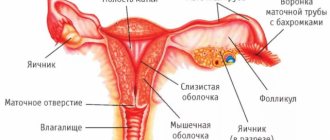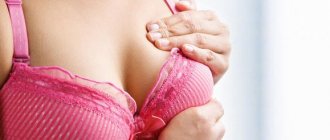A rash in the chest area is redness and irritation that can itch, hurt, and cause other types of discomfort. Some people may experience worse symptoms, such as blisters or peeling skin. A rash under the breasts is usually triggered by warm, moist conditions that can build up between the folds of skin. In medicine, this phenomenon is called diaper rash, or intertriginous dermatitis. This problem often occurs in women with diabetes, those who are overweight or have too large breasts, and also in pregnant women. Typically, a rash in this area appears when the lower lobe of the breast is tightly attached to the rib cage and sweat collects in the fold. This area of high humidity becomes a favorable breeding ground for bacteria, fungi and other pathogens.
Redness and itching in this area of the body cause severe discomfort to the person. Many people are ashamed of this problem. There are several possible causes of a rash under the breasts. One of the most common is cutaneous candidiasis, a serious yeast infection.
Causes of redness under the mammary glands
Irritation under the breasts can occur as a result of wearing a low-quality bra. Itching and redness under the mammary glands can be caused by various factors affecting the body. There may be a violation of hygiene requirements, poorly chosen underwear or low-quality skin care products. There are also more serious problems, the nature of which can be clarified by competent diagnosis.
Allergic reaction
The skin in the chest area is very sensitive and quickly reacts to external irritants with redness and itching:
- Pay attention to the quality of the underwear - its size should correspond to the size of your chest, and the fabric should be moisture-permeable and have a soft structure.
- Perhaps the reason is the washing powder, particles of which remain on the laundry and irritate the skin. It is worth changing the detergent to an analogue with hypoallergenic properties.
- New foods introduced into the diet or exotic dishes are a common cause of an allergic reaction. Review your diet and avoid new products of dubious origin. Perhaps the irritation between the mammary glands will go away in a few days. If this does not happen, you should look for other causes of the inflammatory process on the skin.
Eliminating the factor that causes the allergy will allow you to cope with the problem without medications.
Fungal skin infection
The appearance of fungus under the breast requires a comprehensive examination
A fungal infection that has entered a damaged area of skin can find a favorable habitat here. Especially when it comes to areas under the breasts, where intense sweating occurs and diaper rash occurs. For the fungus, such conditions are optimal, and its vital activity will soon make itself felt with itching and red spots under the breasts. This problem often occurs in people who are overweight. In this case, a comprehensive examination is necessary. It will allow you to clarify the type of fungal infection and select medications that can destroy pathogenic microorganisms.
Hyperhidrosis
During the hot season, the area of skin under the breasts is often covered with patches of diaper rash. Redness under the mammary glands is a consequence of intense sweating and the accumulation of moisture in a closed environment, which is formed by thick underwear and folds between the mammary glands. To cope with the problem, following the rules of personal hygiene, taking a shower several times a day and using cosmetics with a drying effect.
Breast diseases
Lactostasis
Bright red spots under the mammary glands often appear during lactation. If the patient experiences stagnation of milk - lactostasis, the breasts swell due to excess fluid, a burning sensation and itching appear. The process is accompanied by hyperemia, which can only be dealt with by treating the underlying disease.
Often, redness and itching under the mammary glands is a symptom of a tumor process. For example, an itchy rash is a sign of an inflammatory cancer. The process proceeds quite quickly and requires surgical treatment to prevent the inflammation from spreading to neighboring areas of the body.
Redness of the breast is an essential sign of mastitis. It is caused by infections that enter the breast through cracks in the nipples. Prompt diagnosis and qualified treatment are of great importance here, since the situation can quickly develop into a complex inflammatory process, and it will no longer be possible to cope with it using conservative methods.
Scabies mite
Parasitic insects find a favorable moist environment on the surface of the skin under the mammary glands. Their activity causes severe itching and redness of the skin. Symptoms become more pronounced at night, which most likely indicates damage to the body by scabies mites.
Other causes of irritation between the mammary glands
Psoriasis
Medical research shows a connection between the appearance of red spots under the breasts and diseases such as psoriasis, rubella, measles or chickenpox. Their course immediately affects the condition of the skin, causing a rash or inflammation in a focal or continuous form. As a rule, with successful treatment of the underlying disease, hyperemia disappears without a trace within a few days.
Often itching and redness of the skin in the mammary glands indicate hormonal imbalances during pregnancy or lactation. As hormonal levels stabilize, inflammation disappears within a few weeks without special treatment. If a patient of puberty age who is not pregnant or lactation complains of redness, the symptom indicates a lack or excess of hormones. An appropriate blood test and taking medications prescribed by a specialist based on the results of the study will help clarify the clinical picture.
Diseases accompanied by hyperemia in the chest area include atopic dermatitis and diabetes mellitus. In addition, redness of the skin may accompany a decrease in immunity due to a previous illness or poor lifestyle. A comprehensive diagnosis aimed at detecting all possible diseases associated with inflammatory processes on the skin allows you to make an accurate diagnosis or refute initial suspicions.
Any redness in the chest area that does not go away for a long time requires medical monitoring and mandatory diagnosis. This will allow you to detect a hidden disease at the initial stage and eliminate it without consequences for the body.
What do cracked nipples look like?
Identifying a crack in the nipple is not difficult even for a first-time mother. The crack looks like a longitudinal cut, starting from the base of the nipple and running along to its periphery. In the most severe cases, the nipple areola may also crack.
Cracks vary in type and size: they can be either multiple or single, affect one or both breasts at once, be located near the surface or involve deep layers of the skin. From time to time, the cracks may bleed, and ichor may be released from them.
Any, even the slightest mechanical impact on the nipple (for example, touch) causes pain and discomfort, not to mention the child’s attempts to suckle. This causes even more intense pain. Often, it is because of severe pain that mothers refuse to breastfeed.
Cracked nipples are a direct gateway to infection, so a process that seems safe at first glance often becomes complicated. Infectious mastitis may develop, followed by inflammation of the nipples and tissue suppuration, deep ulcers, erosions, etc. may form.
Treatment methods
At the initial stage, you can get rid of the rash on your own. To do this you need:
- take a warm bath, adding an infusion of string or chamomile;
- make a compress with a light pink solution of potassium permanganate;
- if the affected area itches, use hypoallergenic ointment (Fenistil).
By mixing water and milk in equal proportions, you can relieve swelling. Soak a gauze pad in the liquid and apply it to the inflamed area for 10 minutes. The compress is done several times a day as needed.
Official medicine does not deny the benefits of using folk remedies, but if pathogenic microorganisms or a serious illness are detected, drug treatment is necessary.
Before applying ointments, you need to clean the affected area of skin from plaque and moisture: wash with soap, wipe with a weak solution of Furacilin and blot with a towel. For treatment, zinc-containing ointments are prescribed (Zinc ointment, Desitin, Zinocap), the percentage composition of the drug is selected individually. In serious forms of the disease, the affected areas are wiped with a solution of copper or zinc according to a specially designed scheme by the doctor.
For ulcers and cracks, use anti-inflammatory and healing ointments:
- Solcoseryl;
- Bepanten;
- Celestoderm;
- Eplan.
To numb the affected areas, you can use Levomekol. It not only has an anesthetic effect, but also disinfects the skin and promotes the healing of wounds and cracks. For fungal infections, local antimycotic agents are used: Sebozol, Nizorex, Mycozoral. All drugs are applied pointwise. If the integrity of the skin is compromised, then you should not rub the product in, but simply apply it to the affected area.
Degrees of irritation
| Stage of disease development | Signs |
| Stage I | Redness, minor rashes, mild scratching. |
| Stage II | Severe redness, a specific coating with a pungent odor, itching and burning. |
| Stage III | Open wounds and cracks appear, and suppuration is possible. |
Diaper rash in women under the mammary glands goes through several stages of development:
Attention! At a late stage, a woman requires serious treatment. You won't be able to deal with diaper rash on your own. The help of a dermatologist or gynecologist is needed.
Possible complications
When diaper rash appears under the breast, there is a risk of developing a fungal disease
Diaper rash, itching and red spots under the mammary glands cause discomfort and can cause more serious illnesses. Especially if the patient forgets about personal hygiene measures or tries to cope with the problem on his own:
- skin infiltration is likely to develop;
- scratching the affected areas may cause bleeding wounds;
- infection on damaged skin often causes large-scale inflammation over a large area of skin;
- the risk of pyoderma or fungal skin diseases increases.
If hyperemia is detected in the area under the breasts, you should stop self-medicating and undergo a medical examination as soon as possible.
Unconventional methods
If pharmaceutical drugs do not help you or you consider them expensive, then experts recommend the following procedures:
- Wash diaper rash with boiled water, cooled to room temperature, without using soap. Similar measures can be carried out using a weak iodine solution. To do this, take 1-2 drops of the drug per 1 glass of water.
- To treat inflammation, you can make local baths using a decoction of oak bark.
- Diaper rash under the chest is well treated with decoctions made from sage leaves, valerian rhizomes, horsetail herb, marigold flower baskets, verbena leaves, rose flowers. Sometimes all of these components are brewed together.
Dry buckwheat flour, which is sifted through a sieve and used as a powder, also helps with diaper rash.
For washing inflammatory areas, use a decoction of seed oats, eucalyptus leaves, finely chopped roots, fresh leaves of tannic sumac, and others.
Redness on the chest causes discomfort. It occurs in the form of various rashes or spots, and their sizes can range from a few millimeters to 20 centimeters or more. Redness can appear all year round, in both men and women. What causes such phenomena in the chest area?
Diaper rash: description and causes
Diaper rash in the submammary space refers to an inflammatory process localized in the skin folds. Most often, diaper rash occurs in the female population during the hot season. It is during this period that excess moisture accumulates under the breasts, which provokes the active reproduction of pathogenic microorganisms. Friction from clothing can also lead to diaper rash. Red spots under the breasts occur against the background of infectious, fungal and other pathological processes. The risk of diaper rash is especially high in the presence of scratches, abrasions and wounds. The following causes of diaper rash under the breasts are identified:
- Excess body weight.
- Hyperhidrosis.
- Violation of personal hygiene rules.
- Large chest volume.
- Allergic reaction.
- Wearing uncomfortable underwear that rubs the skin.
- Diabetes.
- Dermatological diseases of infectious nature.
The pathological process is activated as a result of careless drying of the skin and poor ventilation in the chest area. Sometimes redness can be caused by taking antibiotics.
Diagnostic measures
The appearance of irritation on the skin under the breasts in men or women is a reason to contact a qualified dermatologist. At the first stage, after a visual examination, the doctor listens to the patient’s complaints and asks clarifying questions to clarify the clinical picture and outline a preliminary diagnosis. Basic tests that are mandatory for everyone who seeks help:
- general blood analysis;
- general urine analysis;
- scraping from the area of redness and itching;
- blood test to determine glucose levels.
Based on the results of diagnostic measures, the specialist selects a treatment method that takes into account the condition of the patient’s body.
Diagnosis of rashes under the breasts
For any rash in the bust area, accompanied by discomfort that does not go away within a week, it is better not to start self-medication, but to immediately consult a doctor.
If necessary, the doctor can prescribe consultations with a therapist, gynecologist, allergist, neurologist, mammologist or other specialists.
If you have skin problems, you usually visit a dermatologist. The doctor will examine the patient’s skin, take a detailed history (manifestation and dynamics of the disease), and prescribe laboratory diagnostics.
It usually includes:
- smear to identify the causative agent of the disease;
- blood and urine tests;
- blood for sugar.
Laboratory tests will help determine the cause of the disease and prescribe appropriate drug treatment.
Treatment of redness in the chest area
In advanced cases of irritation, it is recommended to use solcoseryl
To successfully treat irritation under the mammary glands, local medications against rashes and itching are prescribed - sea buckthorn oil, calendula-based cream, zinc ointment. Their drying and antiseptic effect reduces the area of inflammation and relieves redness. In advanced cases, the patient is recommended to use solcoseryl, levomekol, panthenol or desitin.
Wearing clothes and underwear made from natural fabrics, treating hyperemic areas with antibacterial soap and furatsilin solution, as well as treating areas prone to intense sweating with talcum powder will help to cope with the problem within a few days.
Treatment of cracked nipples
The first place to start is to visit a gynecologist. With the appearance of the first cracks, complications (infections, etc.) may develop. It is important to identify complications early, and only a specialist can do this.
Local treatment: ointments and creams for cracked nipples
You need to lubricate your nipples with special ointments immediately after feeding. Before the next feeding, the ointment (or cream) should be absorbed. If the product does not have time to be absorbed, you should rinse it off with water. The composition of the products includes several components at once, for example, ointments may contain dexpanthenol and lanolin. Depending on which active ingredient is greater in the composition, the products can be classified on this basis.
Preparations and creams based on dexpanthenol
Dexpanthenol is a derivative of pantothenic acid. Dexpanthenol has an active wound healing effect. You should lubricate your nipples immediately after feeding. Before the next feeding, the ointment is washed off.
There are a number of trade names:
- Dexpanthenol (in the form of an ointment, approximate price - 100 rubles).
- Bepanten (the most popular ointment, costs about 300 rubles).
- Korneregel (itself used in ophthalmology, but is suitable for treating cracked nipples, approximate price - 250-270 rubles).
- Mama (special cream from JSC Elfa, cost approximately 150 rubles).
- Panthenol and D-panthenol (in cream form, approximate price - 180 rubles).
Products based on zinc oxide
Zinc oxide has a disinfecting and anti-inflammatory effect, and also prevents infection of damaged skin. Products based on it must be applied in a thin layer.
Trade names:
- Zinc ointment (approximate price - 30 rubles).
- Desitin (in the form of an ointment, approximate price - 250 rubles).
- Zinc paste (approximate price - 30-50 rubles).
- Sudocrem (approximate price - 200 rubles).
- Tsindol (solution, approximate price - 80 rubles).
Creams and ointments based on lanolin
Preparations based on lanolin have softening and anti-inflammatory effects. The drug cannot be rubbed in; it must be applied in a thin layer of 1 mm and washed off before the next feeding of the baby.
Trade names:
- Lanovit with sea buckthorn oil (in cream form, approximate price - 300-350 rubles).
- PureLan 100 (in cream form, approximate price - 400 rubles).
- Lanolin from Mommycare (in cream form, approximate price - 1000 rubles).
- BabyLine (in the form of a cream, approximate price - 250 rubles).
- BabyDream (in cream form).
- NippleCream (from Avent, in the form of a cream, approximate price - 450 rubles).
- Carelan (in the form of a breast care cream).
- Sanosan (in cream form, approximate price - 350 rubles).
- Lanolin from Lansihon (in cream form, approximate price - 750 rubles).
- Nipple cream (manufacturer: Pigeon, approximate price: 250 rubles).
- MultiMam from Ameda (in cream form).
- Dawn (in the form of a cream, approximate price - 150 rubles).
Retinol-based products
Retinol-based preparations soften the skin and promote rapid regeneration of the epidermis. They are based on vitamin A.
Trade names:
- Retinol acetate (vitamin A in oil form, approximate price - 50-70 rubles).
- We see (ointment, approximate price - 200 rubles).
- Radevit (vitamin complex, approximate cost - 350 rubles).
- Retinoic ointment (approximate price - 250-300 rubles).
Preparations and creams based on natural oils
- MammaDonna (serum, approximate price - 600 rubles).
- NaturaHouse (soothing cream, approximate price - 500 rubles).
- MamaComfort (nipple cream, approximate price - 300 rubles).
Creams based on plant extracts and hydromineral raw materials (Vulnuzan)
Increases skin resistance to cracking and other mechanical damage:
- 9 months (balm from Mustela, about 800 rubles).
- Vulnuzan (in ointment form, about 100 rubles).
- Babe Laboratorios (cream).
Special wound healing drugs
Promotes accelerated regeneration of damaged tissues:
- Actovegin (ointment or gel, approximately 200 rubles).
- Solcoseryl (ointment, about 200 rubles).
Causes
- Increased sweating. Due to the effects of sweat, skin irritation, redness, and rashes may develop. Sweat contains acids that cause inflammation in damaged skin. Excessive sweating occurs when:
- wearing clothes that are too warm, out of season;
- diseases in which body temperature is elevated;
- menopause, when thermoregulation failure occurs in the body.
- Large breasts, constant friction of the skin underneath them.
- Allergic reactions to food, personal hygiene products, underwear.
- Wearing underwear of the wrong size (too tight, chafing).
- Infectious diseases, for example, streptoderma.
- Some disorders in the central nervous system.
- One of the manifestations of diabetes mellitus. With this endocrine disease, the skin becomes less elastic, small wounds and injuries heal less well.
Antibacterial agents
Any use of traditional medicine must be agreed with the attending physician.
- Baths with herbal decoctions. For half an hour, take a bath with solutions of medicinal herbs, such as chamomile, string. It is important to make sure that the woman is not allergic to these plants.
- Anti-inflammatory compresses. Crushed herbs (plantain or dandelion) weighing about 100 g are applied under the mammary glands and after that the compress is fixed. You can also use a compress of diluted apple cider vinegar (diluted in water in a 1:1 ratio), but only if there is no pain.
- Powders. You can use both baby powder and oak bark powder. The most important thing is to apply only to completely dry skin. It is not advisable to sprinkle starch on the skin, although such advice is often found. Starch clumps, and these lumps can lead to increased inflammation.
- Herbal decoctions for skin treatment. Cool chamomile decoction should be applied to the affected skin 3 times a day. To prepare the product, you need to boil 15 g of dried chamomile for 10 minutes and then cool. A decoction of oak bark is prepared from 90 g of dry grass and 900 ml of water. Pour boiling water over oak bark and cook over medium heat for 2 hours. The cooled product is ready for use. Yarrow helps cope not only with inflammation, but also with pain. You will need 250 ml of boiling water, pour 80 g of herbs into it. After the product has been infused for an hour, you should boil it for 2 minutes and let it stand for another hour.
- Healing oils. Oils are used in the last stages of treatment, when inflammation has been eliminated. The oil helps the skin recover faster and improves its regeneration. Olive, fir, and sea buckthorn oil should be heated in a water bath and then cooled slightly. This product can be applied to clean skin.
The most popular antibacterial ointments for skin are:
- "Levomekol". Used for burns, ulcers and deep skin lesions. Increases local immunity.
- "Bactroban". Effectively fights staphylococci, and is also active against a strain resistant to methicillin.
- "Gentaxan". A wound-healing, antibacterial drug that eliminates ulcers and various skin lesions.
- "Baneotsin". An antibiotic that quickly and effectively eliminates ulcers and the inflammatory process.
- "Fastin." Antibacterial ointment for the skin, relieves inflammation and eliminates pus. Suitable for the treatment of burn skin lesions.
- "Metrogil" is intended for the treatment of acne and pimples. The drug has antimicrobial and antiprotozoal effects.
- "Klenzit." It also has a pronounced antibacterial effect and is suitable for treating rashes and redness, including in the area under the breasts.
- "Fusiderma". Relieves inflammation and has an anti-allergenic effect. Suitable for the treatment of dermatitis of various origins.
Treatment of irritation under the breasts must be carried out under the supervision of the attending physician, following all the recommendations of a specialist.
Should you stop breastfeeding if you have cracked nipples?
Of course, giving up breastfeeding is not the wisest decision. This will quickly lead to a natural cessation of milk production, and therefore the baby himself will quickly refuse to breastfeed.
If the cracks are single or multiple, but shallow (in short, the process of tissue damage is not too intense), the situation can be saved by special silicone breast pads (Tippee, Avent, Tommee, Medela, Contact, Pigeon, Lindo, Conpol, Nuk, Chicco, etc.) .d.). They protect nipples from injury while still allowing breastfeeding to continue. But if the amount of damage is large, the nipple lesions are significant and bleeding, even this measure will not be enough.
In this case, special treatment cannot be avoided. During treatment, the baby should not be breastfed. This does not mean that the baby will not receive milk. The milk is expressed into a container, and then you need to feed the baby from a pipette or spoon. It’s better to give up bottles right away. It is much easier to suck from them, and therefore the baby may refuse the breast.
If tissue damage is complicated by the development of infection, breastfeeding is also abandoned, and the baby is fed with breast milk after its preliminary pasteurization.
Symptoms and stages
When the disease just begins to develop, areas of redness appear under the breasts, and the woman feels pain and burning. Swelling of the affected skin may occur. If the disease is not dealt with, bacterial and fungal infections occur. The inflamed areas become covered with a white coating. Weeping diaper rash is characterized by the appearance of an unpleasant odor and sticky discharge.
The disease can occur in both acute and chronic forms. With a sluggish process, a woman experiences such unpleasant sensations as peeling of the skin under the mammary glands, itching, and the periodic appearance of rashes for several months and even years.
The chronic form is much more difficult to treat. This is due to developing disorders of the skin structure. In the acute form, the patient complains of severe pain and swelling of the skin. As a rule, contacting a doctor in this case occurs without delay.
- Easy. At the initial stage, a woman is only bothered by redness of the skin and slight itching.
- Average. In this case, the integrity of the skin is compromised and erosions appear.
- Heavy. Severe diaper rash is characterized by the addition of fungal microflora. Ulcers of varying depths appear on the skin.
Nervous rash on the body: causes, photos, treatment
Itching, rashes and redness of the skin under the breasts are usually due to moisture caused by excessive sweating. The problem most often occurs in women in the summer, or when the ambient temperature exceeds 25 °C. Overweight people suffering from metabolic disorders and disruptions in the endocrine system are susceptible to the appearance of a rash. Women with large breasts who wear unsuitable underwear are also at risk.
Infections
Many infectious diseases are accompanied by symptoms in the form of a rash. Infection can be suspected if the following signs are present:
- dizziness,
- malaise, weakness,
- temperature increase,
- nausea.
Redness and rashes under the breasts are typical for the following diseases:
- chickenpox, measles,
- ringworm,
- pharyngitis, scarlet fever,
- mumps, rubella,
- dengue.
The appearance of many small blisters under the breasts may indicate psoriasis. In this case, the affected surface of the skin is subsequently covered with silvery-white scales characteristic of the disease, as in the photo below.
Breast diseases
A rash often indicates pathological processes occurring in the body in a latent form. It can be:
- breast cancer,
- disruption of the recycling process of substances,
- mastitis and other changes in the mammary glands.
Only a mammologist can accurately diagnose the disease after a complete examination.
Allergic skin rash: principles of treatment in different categories of patients
A rash in the form of acne can appear in girls at puberty and in women during pregnancy. Its appearance is caused by changes in hormonal levels and its imbalance. What a rash characteristic of hormonal imbalance looks like can be seen in the photo below. The rash goes away immediately after hormone levels stabilize.
The most common cause of rash is allergies. Rashes can appear without visible preconditions; their localization is not limited to a clearly defined location.
The impetus for development can be animal hair, food or wearing underwear made of synthetic fabrics, as well as other types of allergens. The spots are located not only under the chest, but also on the neck, stomach, arms, face and armpits. The rash resembles urticaria in shape and is represented by a large number of small papules without a core.
Fungus
Causes of development and methods of treatment of fungus under the breast
The presence of a fungal infection in the body is indicated by red spots or a rash. Candidiasis is easily distinguished by the uneven surface of the plaques and the unpleasant odor:
- slight redness with swelling appears,
- rashes in the form of blisters and pustules,
- opening papules form erosion.
High ambient temperatures cause profuse sweating. If a woman's clothes are not comfortable enough, heat rash may appear under the breasts.
Other reasons
Urticaria (urticaria): general concepts
The cause of the rash may be long-term use of medications. Typically, manufacturers indicate in the annotation the possibility of such a phenomenon. Often a reaction occurs during treatment with antibiotics and drugs that suppress the immune system.
Diaper rash in adulthood
During menopause, the skin produces less collagen, so it loses elasticity and becomes vulnerable and thin. It is easily damaged; due to reduced immunity, cracks and abrasions take a long time to heal. The cause of irritation can be anything from rough underwear to a skin reaction to medication. Therefore, it is necessary to inspect problem areas regularly, without waiting for diaper rash under the breast to remind you of itself with discomfort.
Due to age-related changes, the treatment of such patients has its own characteristics:
- The bra should be selected from soft, hygroscopic fabric;
- Dry skin should be compensated with moisturizing creams for sensitive skin with wound-healing capabilities. You can also use baby cream;
- It is useful to wipe the affected areas with extracts of oak bark and chamomile flowers. After drying, apply zinc ointment or baby powder.
Miliaria in adulthood easily becomes chronic, which is why it is so important to maintain personal hygiene and control the condition of the skin.
Rash: causes and characteristics of rashes
A rash in the chest area refers to irritation and redness of the skin, accompanied by itching, soreness and other discomfort. In some cases, a rash in the form of blisters and peeling may also appear.
The causes of red spots under the breasts can be a wide variety of dermatological problems and diseases. However, the nature of the rash will differ in each individual case. The main causes of the rash are as follows:
- Miliaria as a result of increased sweating during the hot season. Blisters are accompanied by itching and are formed due to blockage of the glands responsible for the production of sweat. At the initial stage, the rash consists of small plaques that eventually merge into blisters. As a rule, the rash goes away on its own after a few days. The affected skin should be regularly dried and ventilated. What else could a rash under the breasts mean?
- Dermatological candidiasis. It is a fungal infection. Yeasts are activated in conditions of humidity and high temperature. Candidiasis on the skin is characterized by the appearance of bright red spots. Sometimes the affected areas of the skin may become crusty or wet. If there is glucose in the patient's sweat, the process of fungal reproduction accelerates. Patients with diabetes are at risk.
- Scabies. A highly contagious disease. The causative agent of scabies is a special scabies mite. The parasite moves in the upper layers of the skin and causes an itchy rash. The spots are numerous and have jagged, clear edges. The areas most commonly affected are the armpits, wrists, groin and nipple areas, as well as the inframammary folds.
- Bacterial damage. Most often, the appearance of a rash is caused by Staphylococcus aureus. In this case, in addition to redness and itching, ulcers appear. The infection quickly affects healthy areas of the skin.
- Allergy. This rash under the breasts may appear when wearing certain artificial materials or using harsh detergents.
- Mammary cancer. As cancer pathology progresses, it can lead to death. Signs of a neoplasm in the mammary gland may include a rash accompanied by pain and fever. The rash can affect one or both breasts. The mammary glands require special attention from women. Experts recommend visiting a mammologist several times a year, especially if you are predisposed to cancer.
Why do nipple cracks occur?
Most often, this problem develops from the very first days of breastfeeding. There may be several reasons for this:
- Incorrect attachment of the baby to the breast. The baby may not latch on properly. This is the most common and most likely cause of cracks. In this case, it does not matter at all for how long the mother gives the baby the breast, 3 minutes, 30 minutes or more. But with frequent feeding, nipple irritation becomes more intense, which means cracks with a characteristic pain syndrome appear more actively and rapidly.
- Forced interruption of the feeding process. The skin of the nipples is extremely delicate and excessive impact on it is unacceptable. This is exactly what happens if the mother tries to forcibly interrupt the feeding process and “rip” the nipple out of the baby’s mouth. Reflexively, the child clenches his jaws harder, trying to hold his chest, the skin becomes irritated and cracks. The same thing happens when the baby is not latched to the breast correctly, when the baby's belly is directed upward and not pressed against the mother's body.
- Insufficient or improper breast skin hygiene. Human skin is covered with natural lubricant, preventing drying and exposure to adverse external factors. Often mothers are too diligent in caring for their breasts: they wash their breasts with soap, wipe them dry with a towel, treat them with aggressive household chemicals, as well as antiseptics, etc. At the same time, the natural protective layer of the skin is washed away, leaving the epidermal structures vulnerable.
There are many other possible reasons why nipples develop cracks:
- Increased sensitivity of the skin (individual feature, in particular, we are talking about the skin of the nipple, which is already sensitive to friction).
- Dry skin of the nipple and areola.
- Lack of vitamins (in particular, we are talking about a lack of vitamin A, which is responsible for the normal synthesis of connective tissue).
- Development of lesions of the oral mucosa in a child (thrush, etc.). Leads to irritation of the skin of the nipples by fungi - candida.
- Incorrect technique for expressing excess milk or using a breast pump.
- Mechanical damage to the nipples during feeding (if the child has already developed teeth, he may bite the nipple).
- Milk leakage.
The above mentioned reasons do not exhaust all the many possible reasons, but knowing them you can prevent cracks from appearing. But if cracks have already appeared and made themselves felt, it is important to take the necessary measures to eliminate them in a timely manner.











